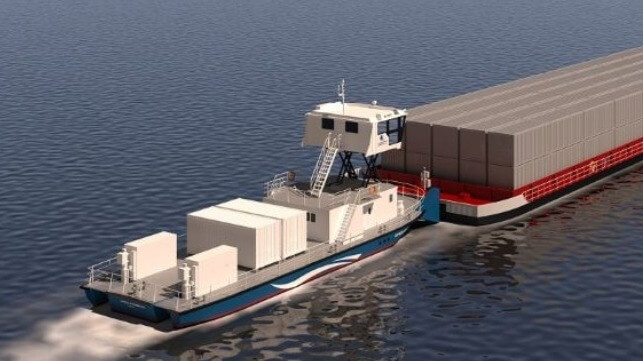Shallow-Draft Electric Pushboat Could Cut CO2 on EU's Inland Waterways

Western Baltic Engineering has developed a novel electric pusher tug specifically suited to shallow waterways, like those found in Lithuania - and, increasingly, all over Europe.
WBE's new "Electric Eel" is designed to run on battery power on a stretch of inland waterway betweek Klaipeda and Kaunas, a distance of about 240 nautical miles. The Lithuanian Inland Waterways Authority commissioned the design for a program to transition truck cargo onto inland barges, thereby reducing emissions. According to WBE head of sales and marketing Egle Mikalauskiene, this single pusher tug could help eliminate 10,000 truck trips a year.
To meet the requirements of Lithuania's inland waterway network, the vessel has to have a draft of less than four feet - a genuine challenge for a 195 dwt tug capable of moving a large cargo barge. Extensive CFD analysis helped refine the hull shape to achieve the form factor and efficiency required for the project. As a side benefit, the tug's small size and light weight mean that it can be built at many regional shipyards.
The electric vessel will run on three separate battery banks, two in twenty-foot containers on deck and one below in a hold. The containerized batteries can be lifted off and exchanged, while the one belowdecks is permanent and can be charged when alongside the quay. Together they store enough power to move the tug and its tow for a distance of 160 nm at a service speed of 12 knots (downriver).
The design is currently awaiting AIP from Bureau Veritas, and once approved, the first model will be built for the Lithuanian Inland Waterways Authority next year.
"We believe our electric pusher is a first mover in the market and can play a critical role in the drive to transform the IWT of Lithuania as well as the Danube and Rhine," said Mikalauskiene in a statement.
Though Europe's inland transport sector is receiving plenty of news coverage because of an ongoing drought, inland waterways account for a very small share of the EU's freight - just six percent, compared with the 75 percent carried by trucking. The EU would like to boost inland waterway and shortsea shipping's share by 50 percent by midcentury in order to reduce emissions.
